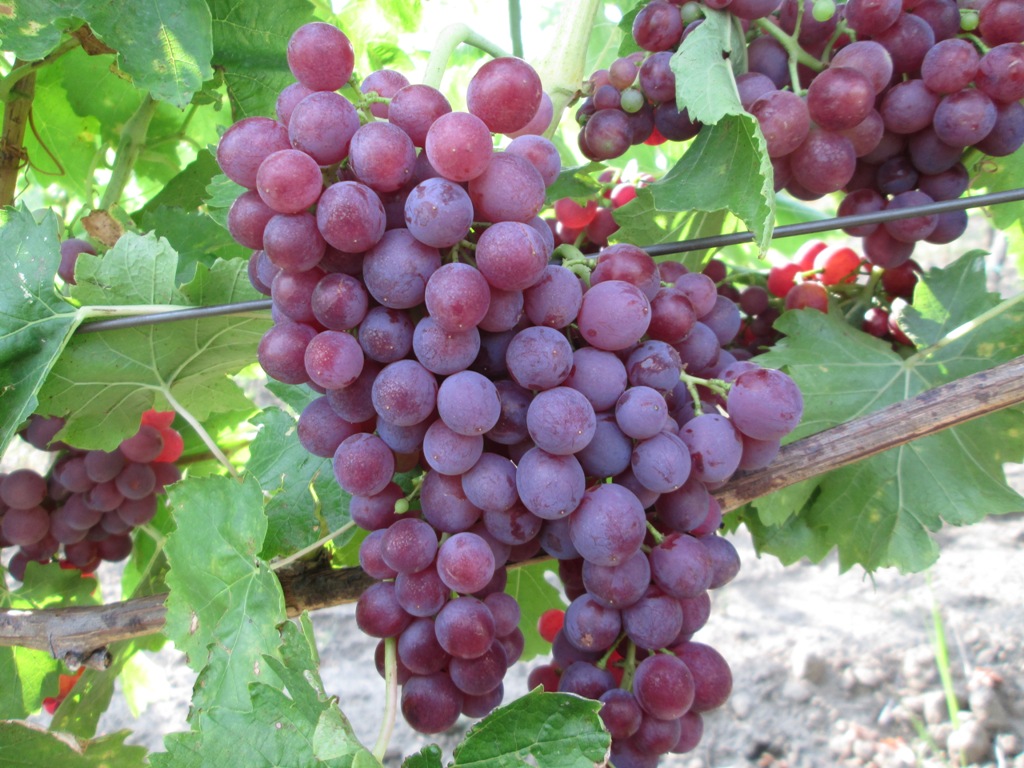
Grape varieties and hybrids of breeder EG Pavlovsky are known not only in Russia, but also in other countries. Thanks to his efforts, more than four dozen forms of culture have been bred, and work is constantly ongoing. Among the new products - a hybrid of teacher’s memory, characterized by extremely early ripening and excellent berry picking rates.
Content
From the history of creation
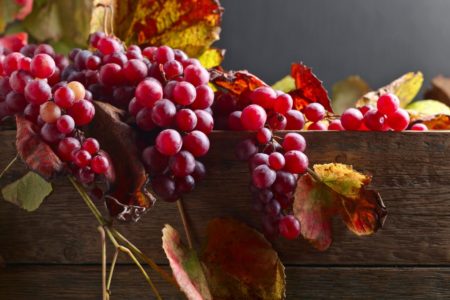
The name for the hybrid early ripe is given in honor of the scientist of the All-Russian Research Institute of Potapenko Ivan Alexandrovich Kostrikov. Collaboration with the scientist yielded results, the amateur bred high-yielding hybrids, bearing fruit even in such harsh regions as Siberia, the Urals, and the North-West of the country.
Parent couple: Russian Talisman and "American" Cardinal. From parents, the hybrid received disease resistance, productivity, unpretentiousness.
Grade description
Bushes form powerful shoots, grow quickly during spring freezing. Young stems are greenish in color, mature branches are brown with a slight reddish tinge. Leaves strongly dissected, held on shoots with the help of red long petioles. Plate with five blades, bright green.
The vine of a hybrid ripens almost one hundred percent. Plant additionally varieties there is no need for pollination. The flowers are bisexual, pollination is excellent. Irrigation with proper care of the plantings is not observed.
Teacher Memory Hybrid is claimed to be super early. Depending on climatic conditions and proper agricultural techniques, berries are harvested already in late July and early August. The total growing season is 95-105 days. Productivity is stable, indicators are above average.
Recommended view for cultivation in regions with a warm climate, in middle lane and to the north it is required to reliably shelter the hybrid from the cold. Frost resistance up to minus 22ºC, but do not test the vine for endurance. It is advisable to prepare the plant for wintering in the fall and shelter in trenches.
Characteristics of berries
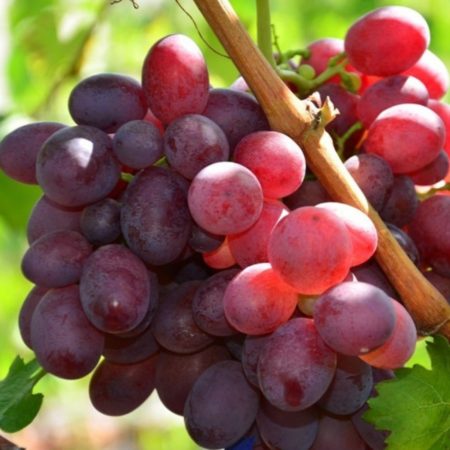
The hybrid form of teacher’s memory is famous for its powerful brushes. The clusters are beautiful, medium density. The shape is conical, sometimes the wing grows. The average weight is 500-1000 grams. With proper care and ideal growing conditions, the brush reaches two kilograms.
Oval berries, weighing 12-15 grams. At first, their color is dark red, as they ripen, the color changes to dark purple with a crimson hue. The skin is of medium thickness, it is not felt when eating. The pulp is fleshy, juicy, with a dense consistency.
A hybrid of a table type, characterized by excellent marketable properties and taste characteristics. The taste is pleasant, with a barely perceptible sourness. Gardeners note a nutmeg, but it depends on the growing conditions. Sugar content - 17-20%.
Berries are used for dessert; tasty juices and compotes are also obtained. Private traders make delicious home-made liqueurs and wine from grapes. Drinks look appetizing, color - rich burgundy.
Advantages and disadvantages
The hybrid from Pavlovsky is appreciated by gardeners from different regions. At the All-Russian contest "Solar bunch" this grape became the winner in the category "Consumer Sympathy" (2015).
Advantages:
- good taste;
- early harvest ripening;
- excellent ripening of the vine;
- resistance to fungal infections;
- unpretentiousness;
- prolonged fruiting.
Berries without discoloration and deterioration of taste hang on bushes for a long time, do not crumble.Brushes do not suffer from rain, keep their shape, berries do not burst. It is noted that prolonged ripening of the berry improves their taste. It becomes saturated, with a musky flavor.
The hybrid grows on various stocks, which is convenient for viticulture experiments. The berries are suitable for transportation, which is important for growing a hybrid for sale.
Disadvantages:
- despite the rather high frost resistance, it is required to cover the vine for the winter;
- it is necessary to carry out normalization, otherwise the yield indicators will significantly decrease next season;
- poorly tolerates extreme heat;
- Needs moderate watering, negatively reacts to soil moisture.
In spring, the shoots of the hybrid are often affected by return frosts. Long-term summer drought affects the quality of berries: the sugar content in the pulp decreases, the taste worsens.
Seat selection and landing
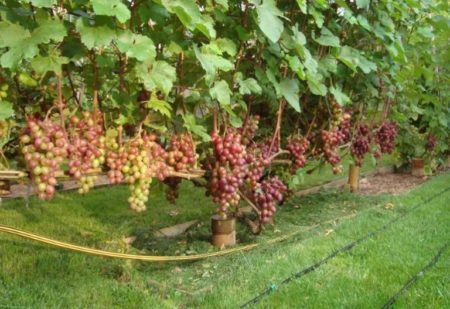
Hybrid planted in well-lit areas. In regions with strong winds, it is advisable to choose a place near the wall, away from any fruit trees.
Any soil is suitable, provided the poor soil is seasoned with fertilizer. Organic matter is added to improve the structure: peat, rotted manure, humus. The culture likes to grow on loam, in addition, on such soils, seedlings are less affected by phylloxera.
Landing dates are determined by the conditions of the region. According to gardeners, this hybrid tolerates planting better in the spring. Seedlings with proper care quickly adapt to the new environment, take root and grow. Autumn planting is recommended only in the south. Tall bushes varieties Teacher memories require a large area of nutrition. Between the seedlings leave a distance of 2-2.2 meters.
Features of agricultural technology
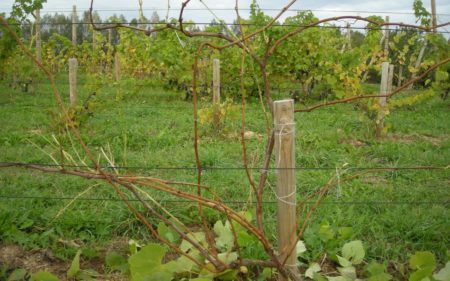
New hybrid are grown in compliance with traditional agricultural techniques. The set is standard:
- watering;
- fertilizing;
- loosening and mulching;
- fight against diseases, pests, prevention;
- Formation of bushes, pruning.
At the same time, there are some subtleties in the care, knowledge of which will allow you to get an excellent harvest.
Watering
In the first year, grape bushes after planting are watered every 7-10 days. Take into account the weather, but do not allow a shortage of moisture. After a month, they switch to longer pauses between watering - up to 20-25 days. In mid-August, watering is completed.
From the second year, the bushes are watered according to an approximate scheme:
- in early spring (provided that the soil is dry, not waterlogged after snow melts);
- before blooming;
- after a period of flowering culture;
- after harvest (in the absence of rain in the fall).
During the ripening of the brushes it is not recommended to water the grapes. Otherwise, the flesh will be watery, the skin will crack.
Top dressing
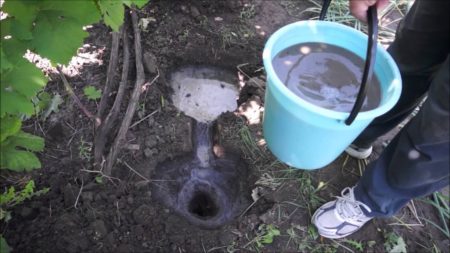
To increase yields and get stable yields every season grape necessarily feed. Comply with fertilizer standards, not exceeding the dosage (especially in cases with mineral additives).
Young vine does not need additional nutrition. For two years, the bushes have enough fertilizers planted during planting. Starting from the third season of feeding, they must:
- before the appearance of flowers;
- two weeks before the formation of berries;
- 16-18 days before harvest.
In the first feeding, organic matter (mullein diluted in water 1:10), nitrophosphate (60 grams per bucket) are added. The second time the grapes are fed with Kalimag (10 grams per bucket of water), ammonium nitrate (20 grams per bucket of water).
In the third top dressing grapes only phosphorus and potassium are needed - to increase the weight of berries and improve palatability. Potassium salt and superphosphate (20 grams per bucket of water) are suitable.
In addition to root, spend spraying grapes on the leaves. Such procedures are effective in cloudy weather, while nutrients are absorbed faster by the plant.
Boric acid is used (3-5 grams of the drug are taken on a bucket of water), ash infusion (liter of ash per 10 liters of water), an extract of superphosphate.
Harvesting
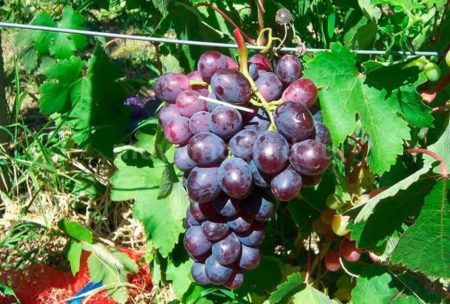
Berries are ready for harvest in early August. In the south, with careful care and favorable weather conditions, berries varieties The memory of the teacher is already ripening by July 25-28.
Experienced winegrowers are in no hurry to harvest, letting the hands mature completely, gain taste and sweetness. In this hybrid, the berries do not crumble, do not ripen. The only threat is the birds, so they necessarily cover the bushes with nets, set rattles.
Disease prevention
The grape hybrid In memory of the teacher is positioned by the creator as resistant and little susceptible to infections. So far, due to the recent appearance of the species on the market, these data are being studied, but reviews by gardeners show that the resistance is high. In this, the hybrid is similar to the “parent” - the Talisman variety, which is little affected by fungal diseases. Prevention includes treatment of plantings throughout the growing season:
- in early April, the bushes are sprayed with a solution of iron sulfate 3%;
- Before the onset of the green cone phase, the plantings are treated with the Vertimek preparation (helps from larvae of pests that survived the wintering);
- at the stage of bud blooming and before the formation of peduncles, they are sprayed with Topaz, Ridomil Gold;
- after flowering, if necessary, treat bushes with Quadris or Strobi.
From the moment berries are formed until the ripening is complete, the use of insecticides is prohibited. If pests are seen on grapes, they use Baikal, Fitosporin bioactive agents, but in very small proportions. In the fall, after harvesting and before hibernation, the culture is sprayed with a 3% solution of iron sulfate.
Pest control
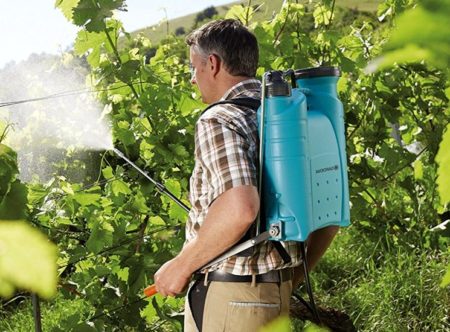
Of the pests "threaten" the grapes:
- leaflets;
- phylloxera;
- marble chips.
Timely prevention allows you to protect plantings from dangerous insects, to prevent their appearance on the site. They process the bushes several times a season, observing the timing of spraying. Sample processing scheme:
- in early spring, while the kidneys are still “sleeping” (use a solution of iron sulfate 3%);
- during the opening of the kidneys;
- before the appearance of flowers;
- after harvesting.
A wide selection of insecticides of various spectrum of action is on sale. In each case, the drug is selected for a specific insect. Treatment with the Kaptan preparation helps with mites, with DNOTK, Keltan, the grapevine does well.
Great damage to the grape plantings. Wasps and birds inflict the memory of the teacher. To protect against birds, nets, ratchets, and stuffed animals are used. Wasps are more difficult to fight, so they use comprehensive protection:
- destroy hornet's nests in the garden;
- set traps from plastic bottles;
- cover the bushes with light and thin non-woven material.
The wasp mesh is not suitable.
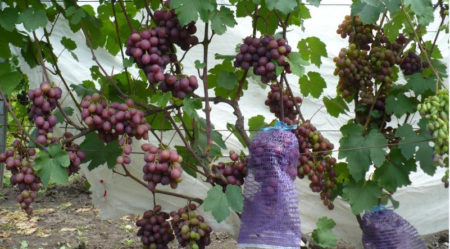
The hybrid form of teacher’s memory, developed by Pavlovsky, a wine grower, deserves the attention of gardeners. Grapes are attracted by productivity, excellent taste. It is suitable for transportation, which makes the hybrid promising for cultivation not only in private vineyards, but also in farms.
Reviews
Konstantin, Volgograd
The hybrid is growing fast, giving gorgeous clusters. Almost all berries are uniform in weight. No watering. The taste is simple, I did not catch a note of nutmeg. I grow for myself and for sale, customers really like this particular grape.
Lyudmila, Kherson
I have been growing this grape for four years.First I tried brushes at an exhibition in Novocherkassk, I liked the taste of this hybrid and decided to choose it for planting. The taste is very good, but it's not for everybody. The presentation is excellent, the brushes are large. I don’t sell it on the market, but the neighbors tried it, they note that the taste is pleasant and the variety is attractive in appearance.




 Non-covering winter-hardy grape varieties for Moscow region
Non-covering winter-hardy grape varieties for Moscow region How to keep the vine in winter
How to keep the vine in winter When can I transfer grapes to another place in the fall
When can I transfer grapes to another place in the fall How to cover and prepare grapes for the winter in the suburbs
How to cover and prepare grapes for the winter in the suburbs